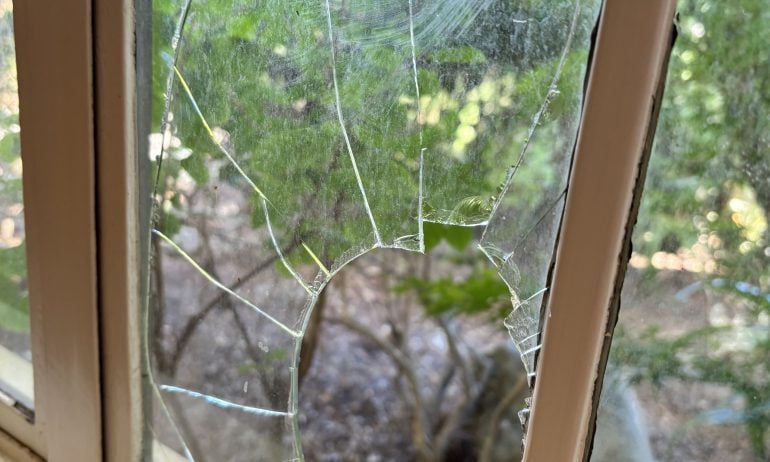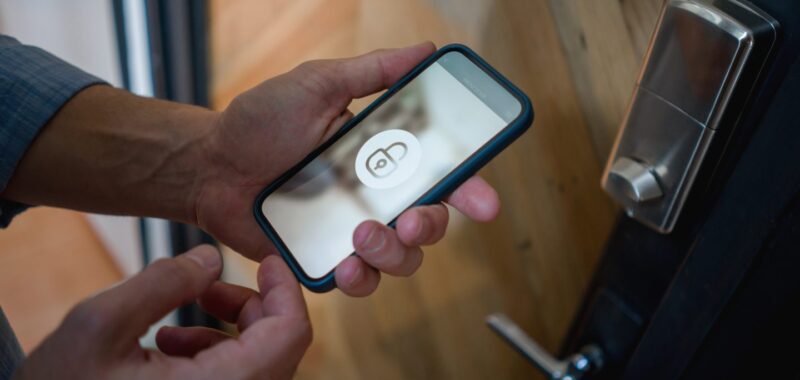A few weeks ago, someone attempted a break-in at my house in the middle of the night. For the first time, my family realized we needed a security system — immediately.
We discussed the most critical factors for our convenience and safety, and I compared those with my experience reviewing home security equipment from various providers.
We chose and installed a DIY system that was easy to set up and operate from a mobile app and had no long-term contract or ongoing fees.
Our previous safety measures
My family locked our doors at night, but sometimes not while we were out for the day. We have had an alarm sticker on a front-facing window that’s likely been there longer than we have, with no alarm system to match.
However, our somewhat relaxed attitude toward security didn’t match our town’s property crime rates. To my surprise, my neighborhood ranked above the national average for property crime in 2022, earning a “C” grade from CrimeGrade.org.
Our attempted break-in experience was a sobering reminder that just because something hasn’t happened before doesn’t mean it won’t, and that it’s much better to be safe than sorry.
The attempted break-in
I woke up on a regular Wednesday morning to find broken glass on my living room floor and a hole above through a street-facing front window pane. It looked like a rock or a branch might have smashed through the glass.

(Photo courtesy of Dalia Ramirez)
We contacted a glass repair company, who came that day to repair the pane and informed us that the crack in the glass surrounding the hole was made with a glass cutter. Whoever cut the glass, they said, then tried to push it through but wasn’t entirely successful.
My family hadn’t even considered the possibility of it being an attempted break-in, especially because, according to the FBI, more residential burglaries occur during the day than at night. We were surprised someone would try to enter while we were home.
Slowly, we started to realize how unprotected our home was. There was a tree right in front of that front window that blocked its view from the street. Our street was completely dark at night, and we had no external lights on our home. Our doors had been locked, but the would-be intruder could have opened the window if they had cut more of the glass.
Worse still, we hadn’t heard the glass break while we were sleeping, and we wouldn’t have had any alert if the window had been opened. We were relieved the intruder was unable to enter, but we knew we might not be so lucky a second time.
Factors we considered
1. Alarm sensors
At a minimum, we wanted door and window sensors that would cause a siren to go off if opened while the system was armed. That excluded camera-only systems such as Blink and Google Nest, which send motion-activated alerts and can emit sirens but don’t have sensors that attach to entry points.
We also wanted a glass-break sensor, which detects the frequency of glass breaking even if a window or door isn’t opened.
2. No ongoing fees or contract
Because we have pets that don’t leave our home, there’s always someone staying in the house, so we didn’t find professional monitoring necessary. This aligned with our desire not to enter a multi-year monitoring contract or pay an ongoing monthly fee.
We also weren’t interested at this time in the advanced features that many providers include with a paid self-monitoring monthly plan, such as video recordings, secret alerts, package detection and smoke/carbon monoxide alarm listening. We might consider upgrading in the future, but our immediate priority was peace of mind.
For example, it was important for us to be able to turn a camera on “live view” to see what was going on outside if we heard a noise. Luckily, the system we chose happens to offer smart detection (differentiating between people and other motion) in its free version, which was a plus.
3. Ability to operate from an app
For our system to work for us, everyone in the household needs to be able to arm and disarm the system and view the cameras from their own mobile phone without having to use a keypad every time.
Some home security providers, such as Ring, only allow remote access with a paid monthly plan. That fee comes with lots of other valuable features, but that wasn’t what we were looking for.
4. Immediate installation
My family didn’t want to wait for a professional technician to install equipment, which is required with providers like Vivint or ADT’s pro-install system. It’s possible that a technician would be able to do a next-day installation, but we didn’t want to take the risk and leave our home vulnerable for another night.
The ADT service in our region says it offers same-day installation, but ADT wasn’t our top pick for other reasons. Some DIY systems, like SimpliSafe, Ring and Arlo are available at retail stores like Best Buy in addition to shipment directly from the company, so those were our best options.
Our top picks
We wanted a DIY system we could set up immediately and operate from our phones that would include traditional alarm sensors and cameras without ongoing fees.
Our provider options, with those factors in mind, included SimpliSafe, Arlo, and Abode. Any of these options would have been a fit for us — I have a colleague who happily uses Arlo — but we ended up choosing SimpliSafe.
Why we chose SimpliSafe
SimpliSafe has a clean privacy record and reasonable equipment pricing, and I like that we have the option of enabling professional monitoring for a month at a time if needed.
The security system has more limited smart home automation and integration capabilities than other providers like Abode and Ring, but we don’t use any smart home products like thermostats or automated lights.
We installed the base hub, sensors on our front and back doors, a glass-break sensor for the front window, a motion sensor monitoring the living room (it differentiates between people and pets, so our pets shouldn’t trigger it), an outdoor camera facing the front yard and a keypad in the bedroom for easy arming and disarming.
The devices were straightforward to install and make chimes and announcements to let me know they’re working. I had no issues with Wi-Fi connectivity, sensor adhesive or alert activation.
There are more high-tech and hands-off security systems on the market that might be a great fit for other homes, but SimpliSafe has been malfunction-free so far and has given us the peace of mind that lets us sleep at night.

